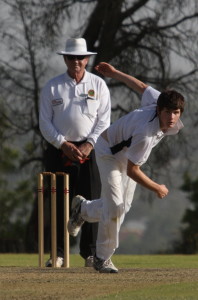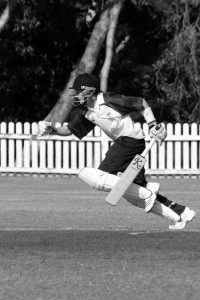Learning how to bowl a good length

This is not a skill that a coach can easily teach. A good coach can teach you to bowl straight, but you, the bowler, will learn the correct lengths with practice and experience. Bowling a certain length requires that you learn the correct release point of the ball from your hand. Bowling with the correct release point is a skill in itself and will take many hours of practice. Hang on to the ball too long and you will bowl too short; let it go too early and it will be too full. Through trial and error, you will develop a feel for the correct release point for the length you are trying to bowl.
Bowling a good length usually means making the batter uncertain whether to play forward or back. If you are able to swing the ball, try and bowl at a length that will draw the batter forward to maximise your chances of getting the edge.
A good length ball is one which hits the pitch too far up for the batter to step back to comfortably and play it as it rises, but too short for him to play it as a full toss or half volley off the front foot. This may vary from ball to ball, depending on the batter’s footwork, and from pitch to pitch if one is dry and the other is damp. A good length ball always gives the batter a minimum of time to know what to do, thus forcing him on the defensive or into taking risks if attempting to play attacking strokes.
Good length varies with the pace you bowl at. A good length ball from a slow bowler will be much closer to the batsman than a good length ball from a fast bowler.
Good length also varies with the height and aggressiveness of the batter. A tall batter can reach forward further than a shorter player, so you will need to bowl a shorter “good” length to the taller player,
The state of the wicket also influences what is or isn’t a good length. The faster the wicket the shorter the ball can be pitched and still be a good length.
What should be the length of my run-up?
There is no definitive answer to this question. It is very much an individual choice. In general, it should be as many paces as you need to accelerate to the speed at which you feel balanced and ready to bowl. However, it is true to say that most young pace bowlers use too long a run-up, hoping to intimidate the batter with its length. They miss-stride and waste the entire run-up, tiring themselves out in the process. Common faults to look out for in this over-long approach include skipping, hopping, and shortening and lengthening the strides.
What should I look at?
Certainly not the bowling crease or your footmarks. You should start by looking down to make sure you are starting from the correct marked position, and then keep your eyes fixed on the target. What should this target be? The top off off-stump is often used. This has two purposes: firstly, it ensures that you are intending to bowl down an appropriate imaginary line; secondly, sports science has shown that we tend to pitch the ball somewhat shorter than what we are looking at.
Which side of the stumps should I bowl from?
Ninety-nine per cent of the time, the answer is simple – over the wicket and as close to the stumps as is comfortable. This will enable you to bowl wicket to wicket rather than at an angle. It will also enable you to gain more movement and maximise your chances of gaining LBW decisions.







